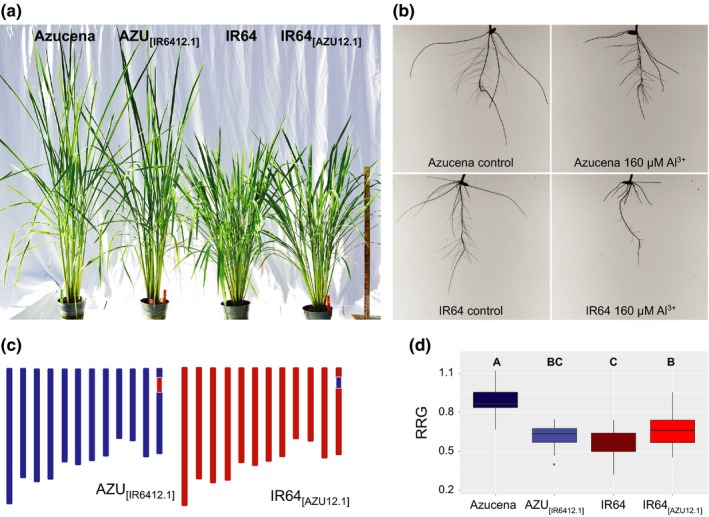Figure 1.

Near‐isogenic lines (NILs) carrying reciprocal introgressions of the Alt12.1 region validate the effect of the QTL on rice Al resistance. (a) Representative plants of the Al‐resistant rice variety Azucena, of the Al‐sensitive variety IR64, and of the reciprocal NILs near‐isogenic lines AZU [ IR 6412.1] and IR64[ AZU 12.1] grown under greenhouse conditions. Photograph taken 110 days after sowing. (b) Parents of the recombinant inbred line (RIL) mapping population used to map Al resistance QTL (Famoso et al., 2011). Azucena (tropical japonica) is Al‐resistant and IR64 (indica) is Al‐sensitive. The photographs show roots of representative five‐day‐old seedlings of Azucena and IR64 grown in hydroponics under control (0 μm Al3+ activity, left) and Al stress (160 μm Al3+ activity, right) condition for five days. (c) Genotypic makeup of the near‐isogenic lines AZU [ IR 6412.1] (left) and IR64[ AZU 12.1] (right). In the schematic representation of the 12 chromosomes of rice, blue denotes Azucena background, and red denotes IR64 background. The reciprocal introgressions at the Alt12.1 region on chromosome 12 are indicated by a blue rectangle in AZU [ IR 6412.1] and by a red rectangle in IR64[ AZU 12.1]. (d) Al resistance phenotypes of Azucena, IR64, and the reciprocal NILs AZU [ IR 6412.1] and IR64[ AZU 12.1]. Relative root growth (RRG) was calculated as the ratio between the total root growth (TRG) of seedlings (n = 18) grown under stress conditions (160 μm Al3+ activity) over TRG of seedlings (n = 18) grown under control conditions (0 μm Al3+ activity)
